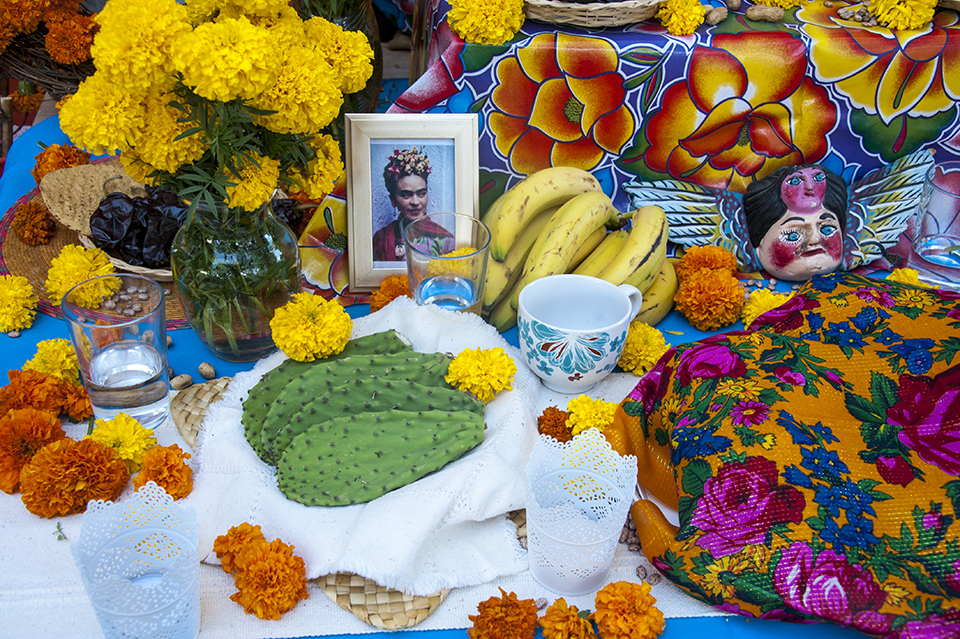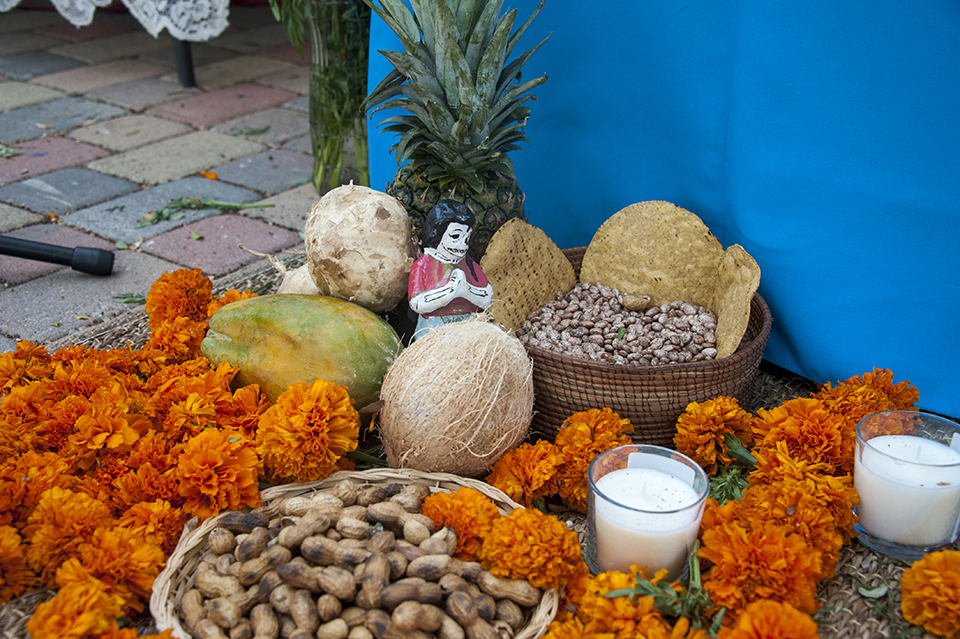Offerings on Ofrendas Invoke Lives of Loved Ones Passed
This article was originally posted on Oct. 30, 2019. CSUN will not be hosting its traditional Día de los Muertos events on campus this year, but a number of online resources are available. Movimiento Estudiantil Chicanx de Aztlan (M.E.Ch.A.) de CSUN is hosting a number of virtual events for students and the community, including webinars on building home ofrendas, and a papel picado (cutting elaborate designs into sheets of tissue paper) online workshop Oct. 22. For more information, visit picuki.com/profile/mecha.de.csun.
The scent from the plate of carne con chile wafted through the air as Veronica Garcia and her family added the finishing touches on their altar. The traditional Mexican dish, consisting of a spicy meat stew with chiles, was her grandmother’s favorite dish.
“We usually don’t celebrate Día de los Muertos, but then my grandma passed away,” said Garcia, a second-year CSUN criminology student. “So we put up an altar in our house with food and photos of her when she was young and when she was older.”
The altar is known as an ofrenda, which is decorated to honor and recall the lives of those who have passed. They can be decorated with flowers, candles, incense, food, drinks and other personal offerings, designed to invoke loved ones to return from the spiritual realm to the earthly realm and have communion with the living. Today, the most commonly recognized decoration is the sugar skull.
Such altars are commonly prepared for Día de los Muertos, an ancient spiritual and cultural celebration of life, death and regeneration originating from the indigenous people of Mexico and Central America, and later combined with Spanish Catholic influences. The annual practice of honoring deceased relatives and loved ones takes place on Nov. 1 and 2.
While brightly-colored sugar skulls may serve as a visual marker signaling the arrival of Día de los Muertos (Day of the Dead), the traditional celebration goes beyond its vibrant aesthetic.
“Día de los Muertos bridges communities,” said Chicana/o studies professor Yreina Cervántez. “Especially here in the United States, it bridges the Latino community with the larger community. It also connects family over generations through the importance of not only remembering our loved ones, but remembering those traditions that help us to maintain a sense of culture and community.”
In Chicana/o studies professor Lara Medina’s essay, “The Shapeshifting Nature of Días de los Muertos and its Role in Chicanx Culture,” Medina explains that at the heart of the Día de los Muertos tradition is the reciprocal exchange of love between the living and the dead.
A common misconception around Día de los Muertos is that it is a tradition strictly embedded in Mexican culture.
The cultural practice of honoring and remembering the dead can be traced to the indigenous peoples of Latin America and Mesoamerica (the regions spreading across central Mexico to Belize, Guatemala, El Salvador, Honduras, Nicaragua and northern Costa Rica).
“Indigenous communities do make the ofrendas,” Cervántez said. “They incorporate calavera imagery, or skull imagery. A lot of times, people don’t understand that the calavera does not just represent death. In the indigenous worldview, it represents the cycle of life, death and rebirth — regeneration.”
Many regions have shared aspects when it comes to observing Día de los Muertos — such as visiting gravesites and constructing ofrendas adorned with offerings to honor the deceased — but it is important to note that each region celebrates in their own unique way.
Accompanied by her family, second-year CSUN student Leslie Cruz honors her Oaxacan roots when building an altar.
“Not a lot of people understand the concept of Día de los Muertos because in Mexico, they have a two-day celebration and other regions, like Oaxaca, celebrate differently,” Cruz said.
The Cruz family offers fruit, traditional pan de muerto (a special bread made for Día de los Muertos) and Oaxacan dishes such as mole con arroz (mole with rice) for their deceased relatives and other loved ones. Photographs are an important element of an altar, but Día de los Muertos is about remembrance overall, Cruz noted.
“It’s really about our loved ones that we decide to remember, rather than whose picture is on [the altar],”Cruz said.



 experience
experience